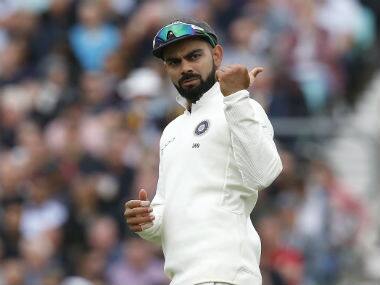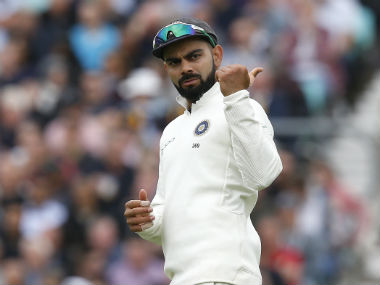West Indies. Home advantage. Do the math. 2-0. There is no disrespect meant here for the Jason Holder-led side. Simply, extending from the English summer, this is a season where scorelines matter and anything else simply won’t do. [caption id=“attachment_5300011” align=“alignleft” width=“380”] Skipper Virat Kohli would look to play a settled squad ahead of the Australia tour. AFP[/caption] Anything less than a comprehensive win in this upcoming Test series against West Indies will be an intense climb-down for the world’s number one ranked side. Or at least, that is how it should feel to both skipper Virat Kohli and coach Ravi Shastri, who have time and again gone defensive whenever talking about the 4-1 defeat in England. Since one has broached the topic, it ought to be made clear that they are right to an extent. Until that scoreline read 3-1, India had a case for saying that they fought tooth and nail in every game barring the Lord’s Test. Even at the Oval, India were in contention until the penultimate session on day five. Yet, history judges you on results and there is nothing that can be said at least to disprove what that 4-1 result tells you. To put it simply, England were the better side through those five Tests and in those conditions. India competed, yes, and perhaps England will not be able to compete to a similar level when they visit the sub-continent next in 2020-21. It doesn’t matter if they do. Why? Because Joe Root and their coach (Trevor Bayliss or whoever replaces him in 2019) don’t walk around blowing their own trumpets, claiming to be the ‘best traveling side in world cricket’, or indeed, the ‘best England side ever’. These tags cannot be claimed. They have to be earned — with intelligent, consistent and winning performances in overseas conditions. For this, you need to make the right selection decisions, duly interspersed with clever judgment calls as per situations, conditions or opposition. The balance herein is about 70-30, or 80-20. You back your core group of players in 70-80 per cent cases, and the rest calls for adventurism. Through South Africa and England, Kohli and Shastri heavily skewered that balance with odd selection calls and thus paid a heavy price for it. Playing at home is comfortable in comparison. Apart from home conditions that suit your batsmen, there isn’t much thought needed in picking the optimal combination. Very rarely is the extra pace bowler needed, unless you are playing in Sri Lanka where additional bounce can come in handy. Mostly, two spinners with two pacers and the sixth batsman is the way to go. And with Hanuma Vihari making his chance count in England, it is a pretty straightforward team selection for the first Test. If at all there is any room for manoeuvring from the team management, it is in deciding who will partner KL Rahul at the top — Prithvi Shaw or Mayank Agarwal. This will come down to what Kohli and Shastri are looking for, and an element of preparation for the Australian tour comes into focus here. Make no mistake, leaving out Shikhar Dhawan and Murali Vijay (earlier in England) only means that the selectors are ready to move on and find the next set of long-term Test openers. Beyond this, it is hard to see what is at stake for India in this contest. The last time these two sides met, Kohli’s side (much the same men) pummelled West Indies in their den 2-0 in the four-Test series. Barring rain in both Jamaica and Trinidad & Tobago, it might as well have been 4-0. The underlying point is that the Indian team didn’t break much of a sweat then, and aren’t expected to move past third gear this time either (unless West Indies work up a miracle, hey!). There is a sticking point, though. The Indian team management — Kohli and Shastri — count that 2-0 score-line as part of the nine Tests won overseas. In turn, it forms the bedrock of their argument that this Indian team is the best seen in past 15-20 years. It puts that whole scoreline malarkey back into focus. 2-0 again, but why does it matter? Does it even? Yes, it surely does because at the moment India are standing on thin ground. Their reputation as the world’s number one Test side is built mostly on home victories, and away wins against Sri Lanka and West Indies. Before the 2018 overseas cycle began, the argument in India’s favour was perhaps that you could only beat the opposition in front of you. Post the tours of South Africa and England, that argument is no longer relevant. Kohli admitted in England that his side would not be satisfied with one-off Test wins. Yet, he overlooked the simple fact that it was precisely what they achieved in both tours this year. The ‘overseas’ factor cannot be overridden here. By some inexplicable force of nature, the team management went into overdrive and played out with team combinations that didn’t really work out. In comparison, home conditions allow for a certain comfort zone. It doesn’t create a situation wherein the positions of Cheteshwar Pujara and Ajinkya Rahane are unduly under threat. There will be tinkering with the team management, and the players can feel safe in terms of selection, period. It will allow the team to prosper in familiarity and regain confidence in what they are capable of. And this last aspect is of grave importance, considering that Australia is waiting just over the horizon.
Skipper Virat Kohli would look to play a settled squad ahead of the Australia tour. AFP[/caption] Anything less than a comprehensive win in this upcoming Test series against West Indies will be an intense climb-down for the world’s number one ranked side. Or at least, that is how it should feel to both skipper Virat Kohli and coach Ravi Shastri, who have time and again gone defensive whenever talking about the 4-1 defeat in England. Since one has broached the topic, it ought to be made clear that they are right to an extent. Until that scoreline read 3-1, India had a case for saying that they fought tooth and nail in every game barring the Lord’s Test. Even at the Oval, India were in contention until the penultimate session on day five. Yet, history judges you on results and there is nothing that can be said at least to disprove what that 4-1 result tells you. To put it simply, England were the better side through those five Tests and in those conditions. India competed, yes, and perhaps England will not be able to compete to a similar level when they visit the sub-continent next in 2020-21. It doesn’t matter if they do. Why? Because Joe Root and their coach (Trevor Bayliss or whoever replaces him in 2019) don’t walk around blowing their own trumpets, claiming to be the ‘best traveling side in world cricket’, or indeed, the ‘best England side ever’. These tags cannot be claimed. They have to be earned — with intelligent, consistent and winning performances in overseas conditions. For this, you need to make the right selection decisions, duly interspersed with clever judgment calls as per situations, conditions or opposition. The balance herein is about 70-30, or 80-20. You back your core group of players in 70-80 per cent cases, and the rest calls for adventurism. Through South Africa and England, Kohli and Shastri heavily skewered that balance with odd selection calls and thus paid a heavy price for it. Playing at home is comfortable in comparison. Apart from home conditions that suit your batsmen, there isn’t much thought needed in picking the optimal combination. Very rarely is the extra pace bowler needed, unless you are playing in Sri Lanka where additional bounce can come in handy. Mostly, two spinners with two pacers and the sixth batsman is the way to go. And with Hanuma Vihari making his chance count in England, it is a pretty straightforward team selection for the first Test. If at all there is any room for manoeuvring from the team management, it is in deciding who will partner KL Rahul at the top — Prithvi Shaw or Mayank Agarwal. This will come down to what Kohli and Shastri are looking for, and an element of preparation for the Australian tour comes into focus here. Make no mistake, leaving out Shikhar Dhawan and Murali Vijay (earlier in England) only means that the selectors are ready to move on and find the next set of long-term Test openers. Beyond this, it is hard to see what is at stake for India in this contest. The last time these two sides met, Kohli’s side (much the same men) pummelled West Indies in their den 2-0 in the four-Test series. Barring rain in both Jamaica and Trinidad & Tobago, it might as well have been 4-0. The underlying point is that the Indian team didn’t break much of a sweat then, and aren’t expected to move past third gear this time either (unless West Indies work up a miracle, hey!). There is a sticking point, though. The Indian team management — Kohli and Shastri — count that 2-0 score-line as part of the nine Tests won overseas. In turn, it forms the bedrock of their argument that this Indian team is the best seen in past 15-20 years. It puts that whole scoreline malarkey back into focus. 2-0 again, but why does it matter? Does it even? Yes, it surely does because at the moment India are standing on thin ground. Their reputation as the world’s number one Test side is built mostly on home victories, and away wins against Sri Lanka and West Indies. Before the 2018 overseas cycle began, the argument in India’s favour was perhaps that you could only beat the opposition in front of you. Post the tours of South Africa and England, that argument is no longer relevant. Kohli admitted in England that his side would not be satisfied with one-off Test wins. Yet, he overlooked the simple fact that it was precisely what they achieved in both tours this year. The ‘overseas’ factor cannot be overridden here. By some inexplicable force of nature, the team management went into overdrive and played out with team combinations that didn’t really work out. In comparison, home conditions allow for a certain comfort zone. It doesn’t create a situation wherein the positions of Cheteshwar Pujara and Ajinkya Rahane are unduly under threat. There will be tinkering with the team management, and the players can feel safe in terms of selection, period. It will allow the team to prosper in familiarity and regain confidence in what they are capable of. And this last aspect is of grave importance, considering that Australia is waiting just over the horizon.
India vs West Indies: Hosts look to solve opening conundrum, regain confidence after England debacle
Chetan Narula
• October 2, 2018, 12:38:33 IST
Fresh from their 1-4 beating in England, India would look for some home comfort against the West Indies and use the two Tests to prepare a settled squad for the upcoming tour Down Under.
Advertisement
)
End of Article